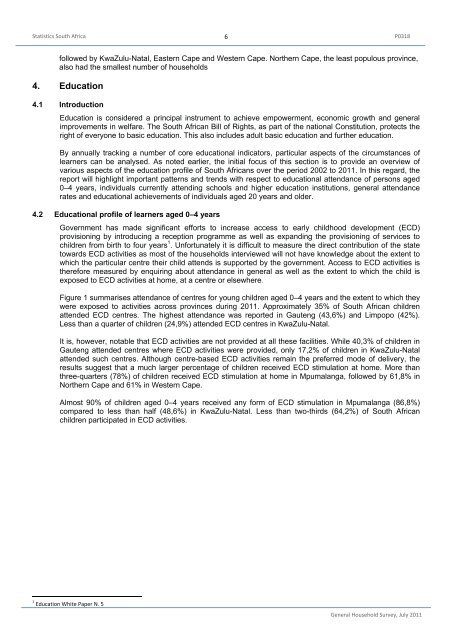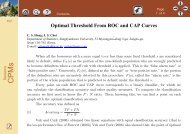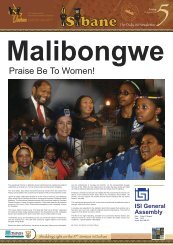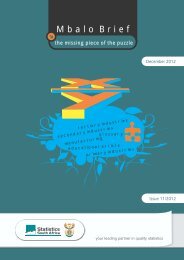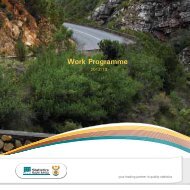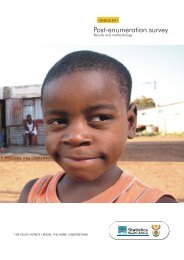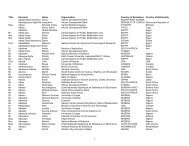General household survey - Statistics South Africa
General household survey - Statistics South Africa
General household survey - Statistics South Africa
You also want an ePaper? Increase the reach of your titles
YUMPU automatically turns print PDFs into web optimized ePapers that Google loves.
<strong>Statistics</strong> <strong>South</strong> <strong>Africa</strong> 6<br />
P0318<br />
followed by KwaZulu-Natal, Eastern Cape and Western Cape. Northern Cape, the least populous province,<br />
also had the smallest number of <strong>household</strong>s<br />
4. Education<br />
4.1 Introduction<br />
Education is considered a principal instrument to achieve empowerment, economic growth and general<br />
improvements in welfare. The <strong>South</strong> <strong>Africa</strong>n Bill of Rights, as part of the national Constitution, protects the<br />
right of everyone to basic education. This also includes adult basic education and further education.<br />
By annually tracking a number of core educational indicators, particular aspects of the circumstances of<br />
learners can be analysed. As noted earlier, the initial focus of this section is to provide an overview of<br />
various aspects of the education profile of <strong>South</strong> <strong>Africa</strong>ns over the period 2002 to 2011. In this regard, the<br />
report will highlight important patterns and trends with respect to educational attendance of persons aged<br />
0–4 years, individuals currently attending schools and higher education institutions, general attendance<br />
rates and educational achievements of individuals aged 20 years and older.<br />
4.2 Educational profile of learners aged 0–4 years<br />
Government has made significant efforts to increase access to early childhood development (ECD)<br />
provisioning by introducing a reception programme as well as expanding the provisioning of services to<br />
children from birth to four years 1 . Unfortunately it is difficult to measure the direct contribution of the state<br />
towards ECD activities as most of the <strong>household</strong>s interviewed will not have knowledge about the extent to<br />
which the particular centre their child attends is supported by the government. Access to ECD activities is<br />
therefore measured by enquiring about attendance in general as well as the extent to which the child is<br />
exposed to ECD activities at home, at a centre or elsewhere.<br />
Figure 1 summarises attendance of centres for young children aged 0–4 years and the extent to which they<br />
were exposed to activities across provinces during 2011. Approximately 35% of <strong>South</strong> <strong>Africa</strong>n children<br />
attended ECD centres. The highest attendance was reported in Gauteng (43,6%) and Limpopo (42%).<br />
Less than a quarter of children (24,9%) attended ECD centres in KwaZulu-Natal.<br />
It is, however, notable that ECD activities are not provided at all these facilities. While 40,3% of children in<br />
Gauteng attended centres where ECD activities were provided, only 17,2% of children in KwaZulu-Natal<br />
attended such centres. Although centre-based ECD activities remain the preferred mode of delivery, the<br />
results suggest that a much larger percentage of children received ECD stimulation at home. More than<br />
three-quarters (78%) of children received ECD stimulation at home in Mpumalanga, followed by 61,8% in<br />
Northern Cape and 61% in Western Cape.<br />
Almost 90% of children aged 0–4 years received any form of ECD stimulation in Mpumalanga (86,8%)<br />
compared to less than half (48,6%) in KwaZulu-Natal. Less than two-thirds (64,2%) of <strong>South</strong> <strong>Africa</strong>n<br />
children participated in ECD activities.<br />
1 Education White Paper N. 5<br />
<strong>General</strong> Household Survey, July 2011


